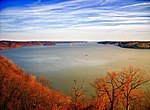The Susquehanna and Tidewater Canal between Wrightsville, Pennsylvania, and Havre de Grace, Maryland, at the head of Chesapeake Bay, provided an interstate shipping alternative to 19th-century arks, rafts, and boats plying the difficult waters of the lower Susquehanna River. Built between 1836 and 1840, it ran 43 miles (69 km) along the west bank of the river and rendered obsolete an older, shorter canal along the east bank. Of its total length, 30 miles (48 km) were in Pennsylvania and 13 miles (21 km) in Maryland. Although rivalry between Philadelphia, Pennsylvania, and Baltimore, Maryland, delayed its construction, the finished canal brought increased shipments of coal and other raw materials to both cities from Pennsylvania's interior. Competition from railroads was a large factor in the canal's decline after 1855. Canal remnants, including a lock keeper's house, have been preserved in Maryland, and locks 12 and 15 have been preserved in Pennsylvania.
A copy of a detailed survey blueprint of the entire canal system including structures and property ownership details was donated (date unknown) by the Safe Harbor Water Power Corporation to Millersville University (assessed on 10/06/2016 in the MU Archives at Sp. Coll. Map 386.409748 S128 Folio). The survey consists of 67 pages, 98 x 30 cm. and is undated but the assumption is the original was created while the canal was in use. The assumed final page (68) which would be a survey of the final lock in Havre de Grace, MD is missing. An original copy (undated) of the survey is located in the Archives of Safe Harbor Dam as of 2022 (Brookfield Renewable). That document is also missing the final page 68.
The survey was completed in 1875 after the January 1, 1872 lease of the Canal to the Reading Railroad. Support for a date of the survey having been completed in 1875 include the fact that the John Bair Warehouse (now Tucquan Club) completed in 1879 (date stone in surviving building) was not on the survey (see map page 23). However, the York Furnace Bridge ruins are indicated. The bridge was destroyed in 1856. This suggests a date between 1856 and 1879.
The confirmation comes from the biography of William H. Dechant of Reading. See Reading and Berks County, Pennsylvania: A History, Volume 3, page 198, Lewis Historical Pub. Co., New York, 1925, by Cyrus T. Fox. Therein it specifically confirms that Mr Dechant, a young surveyor for Reading Railroad, completed the survey in 1875 from Columbia, PA to Havre de Grace, MD. Also see, The_Aegis_and_Intelligencer_Fri__Jul_30__1875, page where it states Mr Dechant finished a complete map of the canal to Havre de Grace in 1875.










